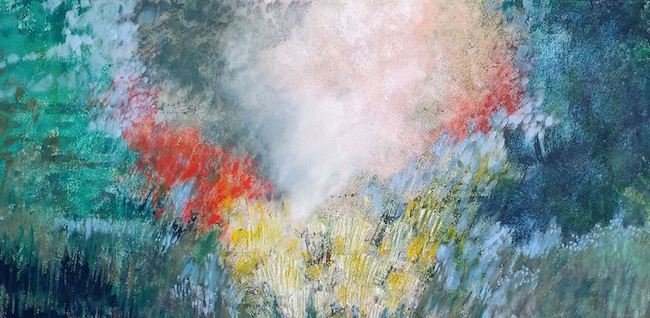L’accesso al mondo interiore è imprescindibile dall’ambiente circostante, da ciò che circonda l’individuo ma soprattutto l’artista e che funge da conduttore tra il ricevere dall’esterno e l’elaborare tutto con il filtro del proprio sentire, della propria specifica sensibilità; a tal scopo spesso i creativi sentono la necessità di scegliere un approccio espressivo libero, privo di qualsiasi regola o dogma a cui attenersi e soprattutto manifestando le emozioni interiori immergendosi in un mondo introspettivo che genera un personale linguaggio artistico. La protagonista di oggi sceglie il fascino della luce, quella luminosità in grado di destabilizzare l’ordine dentro cui l’interiorità spesso tende a rifugiarsi per non perdere un controllo che prima o poi comincia a diventare un limite.
Il momento in cui l’attenzione verso il sentire interiore e la soggettività dell’esecutore dell’opera divenne prioritaria rispetto a qualsiasi tipo di ricerca fino a poco prima effettuata dagli artisti dei primi decenni del Ventesimo secolo, tutto ciò che era stato teorizzato ed elaborato in precedenza perse ogni senso, proprio a causa di quella mancanza di coinvolgimento emozionale che, se da un lato intrigava il mondo intellettuale, dall’altro però allontanava il pubblico che non riusciva a entrare in empatia con l’opera d’arte. Il primo a parlare di emozione, di sottile filo comunicativo tra l’artista e la tela che era espressione delle sensazioni provate anche solo ascoltando dei brani musicali fu Vassily Kandinsky, fondatore dell’Astrattismo in virtù del quale decretò il distacco da tutto il percorso figurativo dei secoli precedenti, ma che voleva, nella sua intenzione, porre in evidenza la non necessità di legare l’emozione a qualcosa di conosciuto dimostrando che non era l’immagine a essere fondamentale per l’intensità del sentire. Quel percorso però fu subito oltrepassato dalla necessità di molti creativi di distaccarsi dalla realtà osservata, quella medesima realtà divenuta troppo brutta a causa del primo conflitto mondiale, per essere fonte di ispirazione; fu così che gli esponenti del Suprematismo, di cui fu maestro Kazimir Malević, e del De Stijl detto anche Neoplasticismo, vollero affermare l’indipendenza del gesto plastico e della bellezza creativa da qualsiasi influenza emotiva, da ogni contaminazione del soggetto sull’oggetto. A quel punto dunque l’ordine, la geometricità, i colori primari, divennero la base dell’opera d’arte che in qualche modo, seppur non nell’intenzione di Piet Mondrian o Theo Van Doesburg, mostrava un’esigenza di sfuggire da una realtà troppo triste e spaventosa per poter essere riprodotta. Poi però, superato il distacco più assoluto, effettuata la ricerca verso un sempre più asettico approccio alla tela culminato con lo Spazialismo di Lucio Fontana, ritrovata la pace dopo la fine della seconda guerra mondiale, divenne necessario un ricongiungimento con quel mondo emotivo lasciato in silenzio, allontanato dall’espressione artistica e fu l’Espressionismo Astratto a decretare quel ritorno alla soggettività dell’artista che doveva diventare essenza stessa dell’opera d’arte. Impulso, riflessione, vivacità o atmosfere sognanti, non importava l’effetto finale né tanto meno la tecnica attraverso la quale veniva ottenuto, ciò che contava era quell’espressione interiore che doveva prevalere e fuoriuscire per giungere diretta verso le corde emotive dell’osservatore, coinvolgerlo, scuoterlo.
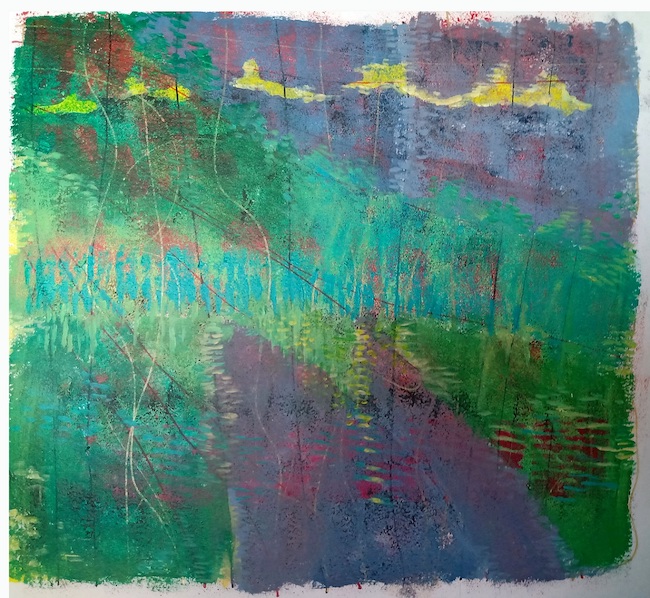
L’artista argentina Ana Maria Tobanelli si avvicina al movimento teorizzato e fondato da Jackson Pollock proprio per rompere tutti gli schemi e le gabbie della razionalità, del controllo della mente, per entrare nel mondo del caos, della confusione percettiva che si sprigiona quando il contatto con le sensazioni è aperto, quando la luminosità interiore si accorda a quella esteriore dando vita a un mondo scomposto eppure incredibilmente in equilibrio con il sentire, con l’universo emozionale che si nasconde dentro ciascun individuo. Ciò che per lei è fondamentale è l’apporto della luce, quell’elemento in grado di trasformare un punto di vista, di penetrare il flusso ordinato dei pensieri di superficie e consentire all’impulso di scendere verso le profondità sovvertendo regole e confini autoimposti dalla mente per permettere alle emozioni di liberarsi e dar vita a una più morbida e magica interpretazione del mondo circostante. Il suo Espressionismo Astratto alcune volte si spinge nel mondo dell’indefinitezza, del vortice di sensazioni che non possono essere in alcun modo arginate da una realtà conosciuta, mentre altre nasconde un’apparenza figurativa, parte da una base visiva per poi entrare nell’interpretazione emozionale attraverso tonalità morbide, soffici, come se il suo stesso sentire non potesse fare a meno della lirica poetica che lo sguardo riceve dai panorami e dalle atmosfere che li avvolgono.
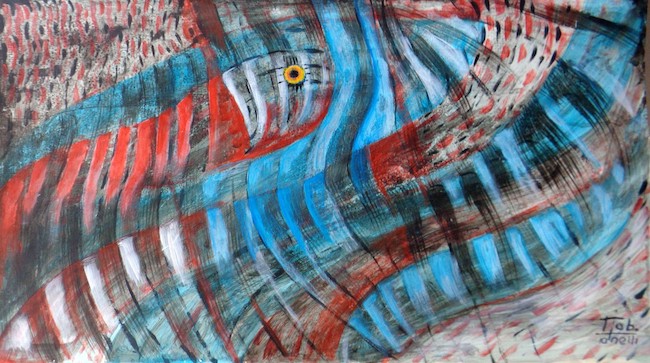
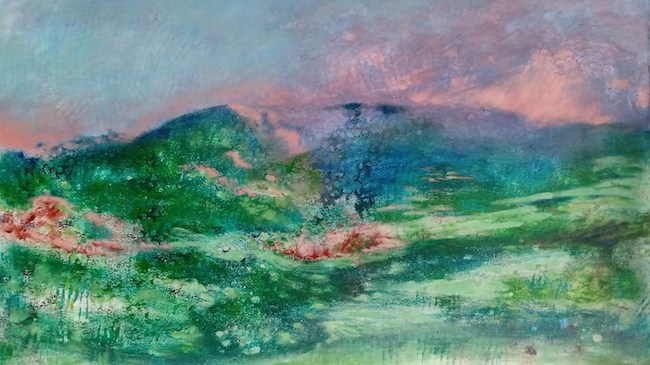
L’opera Verdes (Verdi) descrive un paesaggio incontaminato, rigoglioso e avvolgente ma al tempo stesso indefinito, sfumato, quasi come fosse un ricordo nella memoria della Tobanelli, come se aver raffigurato quelle verdi colline fosse un impulso al quale l’interiorità non ha potuto resistere; le tonalità cipriate rappresentano il mondo emozionale, quella capacità dell’artista di assorbire la delicatezza e la freschezza dell’aria nel momento in cui era immersa in quella natura, mentre il cielo tra il rosa e l’azzurro esprime la sottile nostalgia per quel frangente che non tornerà più, non nello stesso modo, non con le stesse caratteristiche.
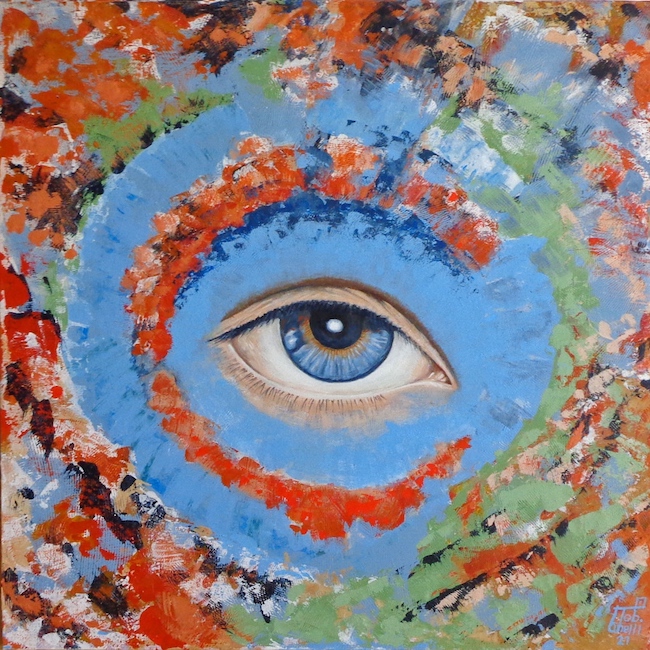
Anche in Te vemos, nos ves (Ti vediamo, ci vedi) l’artista mantiene una parte figurativa che emerge da un contorno irreale, decontestualizzato quasi alla maniera surrealista, perché in questo caso lo sguardo, l’occhio, rappresenta forse quello di un’entità superiore, non giudicante bensì osservante delle azioni del singolo come di quelle dell’umanità, troppo spesso impegnata a distruggersi o a rovinare il mondo in cui vive tanto quanto l’individuo tende frequentemente a essere eccessivamente egoista, a considerare se stesso sopra ogni cosa rischiando di prevaricare o semplicemente ignorare chi gli sta accanto. Lo sguardo dunque appare come un monito, un invito a non dimenticarsi di essere umani perché prima o poi sarà necessario fare i conti con i propri errori, con la propria coscienza, probabilmente quando sarà troppo tardi per porre rimedio alle azioni.
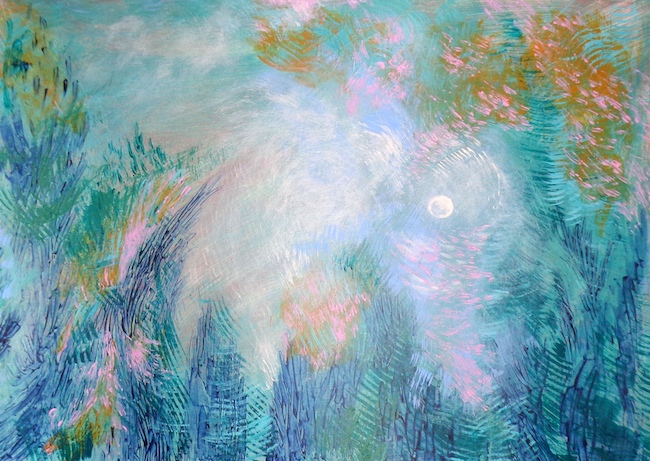
La tela Luna entre glicinas (Luna tra i glicini) invece si sposta verso il mondo della non forma, quell’universo scomposto e sconfinato che si manifesta quando la Tobanelli si lascia andare alle emozioni, quando si tuffa all’interno di un caos dinamico e funzionale a comprendere se stessa ma anche a indurre l’osservatore a lasciarsi trascinare, o forse sarebbe meglio dire guidare, verso quel percorso di connessione tra il mondo circostante e le proprie corde interiori che troppo spesso non riescono a vibrare se non adeguatamente sollecitate da chi in quell’universo emozionale costantemente si muove. La luce della luna è intensa, forte, squarcia il buio e sembra muovere i sottili steli dei glicini, diffondendosi su tutto il paesaggio sottostante che di quell’inattesa luminosità si nutre; l’incisività dell’effetto di rottura dell’equilibrio è dato dall’artista attraverso il grattage con il quale sottolinea le delicate piante a intensificare l’effetto rifrangente di quel chiarore che appare metafora di un risveglio della coscienza, di un’uscita da una zona sicura per esplorare nuove strade, nuovi punti di vista, inedite sfaccettature fino a poco prima non prese in considerazione.
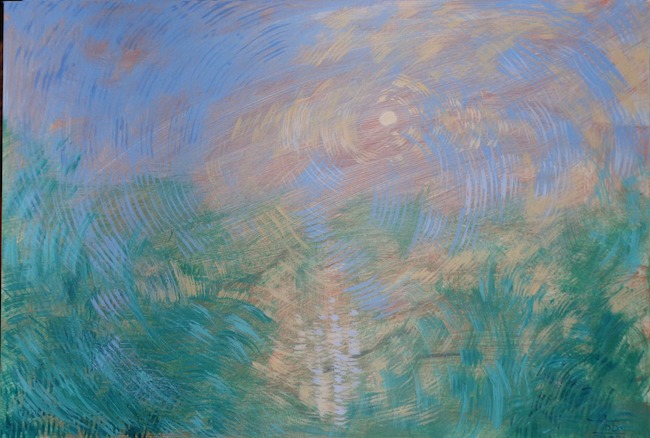
E ancora in Amanese (Alba), il chiarore è ancora protagonista, come in tutte le opere della Tobanelli, e rappresenta la nascita di un nuovo giorno ma anche l’auspicio che tutte le situazioni, anche le più apparentemente cupe, possano modificarsi e trovare nuova linfa vitale proprio in virtù della capacità dell’individuo di guardare verso le possibilità, verso quell’unica apertura in grado di modificare il corso di ciò che invece sembrerebbe destinato a restare immutato. Emerge una costante positività dalle tele di Ana Maria Tobanelli, un approccio sorridente alla vita e anche alla capacità di accogliere gli eventi cercandone costantemente il lato positivo, mostrando all’osservatore che esiste un altro punto di vista, meno oggettivo, più sognante ma ugualmente possibile. Nel corso della sua lunga carriera Ana Maria Tobanelli ha partecipato a molte mostre collettive in Argentina, Italia e Stati Uniti – Firenze, New York, Miami –, ha all’attivo undici mostre personali, ha vinto numerosi premi d’arte, le sue opere sono inserite all’interno di pubblicazioni di rilievo, oltre ad avere molti lavori all’interno di musei ed edifici pubblici e in collezioni private.
ANA MARIA TOBANELLI-CONTATTI
Email: anamtobanelli@gmail.com
Facebook: https://www.facebook.com/anamaria.tobanelli
Instagram: https://www.instagram.com/anamariatobanelli/
The breaking of order through the emotional explosion of light in Abstract Expressionism by Ana Maria Tobanelli
Access to the inner world is inseparable from the surrounding environment, from what surrounds the individual but above all the artist, and which acts as a conductor between receiving from the outside and processing everything with the filter of one’s own feeling, one’s own specific sensitivity; to this end, creative artists often feel the need to choose a free expressive approach, without any rules or dogma to adhere to and above all manifesting their inner emotions by immersing themselves in an introspective world that generates a personal artistic language. Today’s protagonist chooses the fascination of light, that luminosity capable of destabilising the order within which interiority often tends to take refuge so as not to lose control, which sooner or later begins to become a limit.
When attention to the inner feelings and subjectivity of the artist became a priority over any kind of research carried out until recently by artists in the first decades of the twentieth century, everything that had previously been theorised and elaborated lost all sense, precisely because of the lack of emotional involvement which, while on the one hand intrigued the intellectual world, on the other hand alienated the public, who were unable to empathise with the artwork. The first to speak of emotion, of a subtle communicative thread between the artist and the canvas that was an expression of the sensations felt even if only by listening to music, was Vassily Kandinsky, founder of Abstractionism, by virtue of which he decreed the detachment from the entire figurative path of previous centuries, but who wanted, in his intention, to highlight the need not to link emotion to something known, demonstrating that it was not the image that was fundamental to the intensity of feeling. This path, however, was soon overtaken by the need of many creatives to detach themselves from the observed reality, the same reality that had become too ugly due to the First World War to be a source of inspiration. Thus it was that the exponents of Suprematism, of which Kazimir Malević was the master, and of De Stijl, also known as Neoplasticism, wanted to affirm the independence of the plastic gesture and of creative beauty from any emotional influence, from any contamination of the subject on the object. At that point, therefore, order, geometricity and primary colours became the basis of the artwork which in some way, although not in the intention of Piet Mondrian or Theo Van Doesburg, showed a need to escape from a reality too sad and frightening to be reproduced.
Then, however, once the most absolute detachment had been overcome, the search for an increasingly aseptic approach to the canvas culminated in Lucio Fontana’s Spatialism, and peace had been restored after the end of the Second World War, it became necessary to reconnect with that emotional world left in silence, removed from artistic expression, and it was Abstract Expressionism that decreed that return to the subjectivity of the artist that was to become the very essence of the work of art. Impulse, reflection, vivacity or dreamy atmospheres, the final effect did not matter, nor did the technique through which it was obtained, what mattered was that inner expression that had to prevail and escape to reach directly the emotional chords of the observer, involving him, shaking him. Argentinean artist Ana Maria Tobanelli approached the movement theorised and founded by Jackson Pollock precisely in order to break all the moulds and cages of rationality and mind control, to enter the world of chaos, of the perceptual confusion that is released when contact with sensations is open, when inner luminosity is in tune with outer luminosity, giving life to a world that is decomposed yet incredibly balanced with feeling, with the emotional universe that is hidden within each individual. What is fundamental for her is the contribution of light, that element capable of transforming a point of view, of penetrating the orderly flow of surface thoughts and allowing the impulse to descend towards the depths, subverting rules and self-imposed boundaries of the mind to allow emotions to free themselves and give life to a softer and more magical interpretation of the surrounding world. Her Abstract Expressionism sometimes pushes into the world of indefiniteness, of the vortex of sensations that cannot in any way be contained by a known reality, while at other times it conceals a figurative appearance, starting from a visual basis and then entering into emotional interpretation through soft, fluffy tones, as if her own feelings could not do without the poetic lyricism that her gaze receives from the landscapes and atmospheres surrounding them.
The artwork Verdes (Greens) describes an uncontaminated landscape, luxuriant and enveloping but at the same time indefinite, blurred, almost as if it were a remembrance in Tobanelli’s memory, as if having depicted those green hills were an impulse to which her interiority could not resist; the powdery tones represent the emotional world, the artist’s capacity to absorb the delicacy and freshness of the air at the moment when she was immersed in that nature, while the sky between pink and blue expresses the subtle nostalgia for that moment which will never return, not in the same way, not with the same characteristics. In Te vemos, nos ves (We see you, you see us) the artist also maintains a figurative part that emerges from an unreal outline, decontextualised almost in the Surrealist manner, because in this case the gaze, the eye, perhaps represents that of a superior entity, not judging but observing the actions of the individual as well as those of humanity, All too often they are busy destroying themselves or ruining the world in which they live, just as the individual tends to be excessively selfish, to consider himself above all else, risking prevaricating or simply ignoring those around him.
The gaze therefore appears as a warning, an invitation not to forget that we are human, because sooner or later we will have to come to terms with our mistakes, with our conscience, probably when it will be too late to remedy our actions. The canvas Luna entre glicinas (Moon among wisterias), on the other hand, moves towards the world of non-form, that disjointed and boundless universe that manifests itself when Tobanelli lets herself go to her emotions, when she plunges into a dynamic chaos, functional to understand herself but also to inducing the observer to let himself be dragged, or perhaps it would be better to say guided, towards that path of connection between the surrounding world and his own interior chords that all too often fail to vibrate if not adequately stimulated by those who constantly move in that emotional universe. The light of the moon is intense, strong, it pierces the darkness and seems to move the thin stems of the wisteria, spreading over the entire landscape below, which is nourished by that unexpected luminosity; the incisiveness of the effect of breaking the balance is given by the artist through the grattage with which he emphasises the delicate plants to intensify the refractive effect of that glow which appears to be a metaphor for an awakening of consciousness, for leaving a safe zone to explore new roads, new points of view, new facets not taken into consideration until recently.
And again in Amanese (Dawn), flare is once more protagonist, as in all Tobanelli’s artworks, and represents the birth of a new day but also the hope that all situations, even the most apparently gloomy ones, can be modified and find new lifeblood precisely by virtue of the individual’s ability to look towards possibilities, towards that one opening capable of modifying the course of what instead seems destined to remain unchanged. A constant positivity emerges from Ana Maria Tobanelli’s canvases, a smiling approach to life and also the ability to accept events, constantly seeking their positive side, showing the observer that there is another point of view, less objective, more dreamy but equally possible. Over the course of her long career, Ana Maria Tobanelli has taken part in many group exhibitions in Argentina, Italy and the United States – Florence, New York, Miami -, she has eleven solo shows to her credit, she has won numerous art awards, her artworks are included in important publications, as well as has many paintings in museums and public buildings and in private collections.


